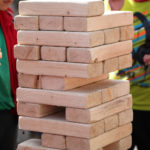There are various ways to practice the popular sport of golf in the comfort of your backyard. This guide will focus on three main categories for you to practice golf at home. They are full swing shots, putting, and wedge play. Due to size constraints, not everyone will be able to do this in their backyard. However, we will give you some good ideas to try nonetheless.
Wedge Play
If you have a lawn that you don’t mind tearing up a bit, there are great ways to sharpen your wedge game. Since the size of your lawn may be a limiting factor, you may end up working on a shorter chip and pitch shot. This will allow you to work on turf interaction, trajectory, and distance control.
Distance Control
Distance control is how well the ball lands within an intended distance. If you can consistently land your ball on the green and keep it there, you will have mastered one of the greatest golf challenges, preventing double bogeys and bogeys.
Whenever you practice a wedge shot, make sure you have an intended target. It may be a bucket, cup, baseball hat, or tree. You can hone distance control while actively attempting to land your ball within a reasonable distance of the target.
Mix up practice between random and repetitive targets.
- Select a target and hit 5-10 balls into it consecutively. Pay attention to the overall proximity.
- Randomly test your skills. Establish four to five targets around the yard at varying distances. Randomly shoot to each.
- Play leapfrog. Do this by hitting the first golf shot using a shorter distance. Then, progressively land the next few practice golf balls one step further. You can play leapfrog in reverse as well, moving from long shots to shorter shots.
Trajectory
How high or low your wedge shot goes through the air is vital to getting a good score. Lower trajectories roll out more while on the green. Higher shots stop quicker. The way to control trajectory is with club selection. Do chipping practice using an eight iron to get the golf ball going on a lower trajectory over a sand wedge.
To help with trajectory, select a target. Try to land your golf ball at the same distance using a low, medium, and high trajectory. You can vary your clubs, experiment with your ball’s position, open and close the face, and alternate techniques.
Full Shots

These are complete swing shots like you would do down the fairway. You will need to master distance and reading different lies to make the best shot in the fewest strokes possible.
Interacting with the Turf
Interacting with the turf involves knowing how to read your lies. Not every ball sits perfectly along a fairway. When landing in the rough, you may find yourself dealing with different lies, from being buried to being on fluffy grass. The technique and selection of the club will need to be adjusted.
While your yard may take some abuse, you can experiment with different lies during golf practice to see how your clubs react. The general idea is as follows:
- If you are buried, get a bit steeper with the club’s delivery. View it as a plane taking a nosedive. Use a club with bounce and loft (sand wedge). The goal is to limit the time the club interacts with grass as it slows the club down and twists the face. This makes it harder to control trajectory and distance.
- If the ball is on the top of your grass, do the opposite. Take a shallow approach when hitting your ball. It should be like making a gentle landing on a runway. It helps to consider it more of a putting stroke while gently rocking the hips back and forth. Do not engage the hands much.
You can also provide yourself with a variety of lies to practice with. See how altering a club selection or technique changes results. This way, when you are on the course, you will understand how your ball reacts while playing these shots.
Putting

When you are playing golf, there are three critical skills you must master:
- Starting your ball on the intended line
- Reading the green
- Speed control
You may not be able to practice all these skills at home. For most people, golf practice at home will focus on stroke quality.
Distances Make a Difference in Your Game
Practicing putting techniques inside ten feet is important. They are the appropriate distances where most golfers have a good chance of making the putt. If we look at the distances and the percentage of success for the shot according to skill level, it yields the following results:
- For a two-foot shot, a tour pro has a 99% chance of making it. A scratch golfer’s percentage will be 99% and a 90 shooter will have a 95% chance.
- Three-foot shots will yield a 96% chance at success for a tour pro, a scratch golfer will have a 93% chance of success, and a 90 shooter will have an 84% success rate.
- A four-foot shot will generate 88% success with a tour pro, an 80% chance with a scratch golfer, and 65% success with a 90 shooter.
- For a five-foot shot, the success rates are 77% for a tour pro, 66% for a scratch golfer, and 50% for a 90 shooter.
- An eight-foot shot will generate a success rate of 50% (pro), 41% (scratch golfer), and 27% (90 shooter).
- Ten-foot shots will provide a 40% chance for a pro, 33% chance for scratch golfers, and 20% chance for a 90 shooter.
- Lastly, a 20-foot shot will have a 15% completion for a pro, 14% for a scratch golfer, and a 6% chance for a 90 shooter.
These guides provide a benchmark for your progress. Different games exist and will help you challenge yourself while building putting skills. Some practice drills include:
- Choose a distance to see the number of putts you can make consecutively. Use a leaderboard to track your best scores at each distance.
- Line six balls up a foot apart. If you sink the first putt, then move to the next. For each miss, start over again. See if you can get to the last putt. For an extra challenge, keep going using a smaller hole or increase the number of putts necessary to make it to each of your stations.
- A variation of this is to change the position of each ball. This will force you to re-align before doing the next putt.
Chipping
This drill does not require a lot of space and can be easily done in any backyard. This will help you understand distances.
To do this, grab a bucket or chipping golf net. Set everything up in the middle of your yard. Practice hitting shots at various distances, and practice with various clubs/lofts to discover what is the most comfortable.
Things You Can Use
Some people choose to use a carpet in their hallway or outdoors and a glass cup. This is a good basic start, but an affordable training aid called “PuttOUT” is an excellent tool for providing more of a challenge to your golf game.
Using a Net
While not everyone has space to hit a full shot into a net, if you do, there are plenty of meaningful drills.
Impact Practice
The place of impact on the club’s face is important to the quality of your shot. Spray Dr. Scholls Foot Spray on the face of your club and hit the ball. The clean area will indicate where you are making an impact.

Practicing Tempo
Practicing tempo involves hitting balls into your net and working on swing tempo, repeating the right swing tempo repeatedly. It will increase your distance on the golf course.
Begin by using the Orange Whip training aid, then use Tour Tempo tones found on your smartphone. Measure results with a swing analyzer.
Use a Launch Monitor
This provides feedback while practicing your swing into your net.
Another thing you can do is swing speed drills. To work on it, you will need small windows for your ball to land. If you are ten feet away, keep the ball within 6-12 inches. As you get further away, expand your window.
While practicing at home, the goal is to improve your swing and technique. The most challenging aspect of golf is that people don’t get better while playing each year. You must be strategic in improving our game and have a solid improvement plan.
Golf is a challenging game, and players must focus on three fundamentals. The first is controlling the low point on the swing. The second is controlling a start line/curve. The third is that you need to have enough speed to play golf.
There are easy techniques you can use when you practice golf at home. During the off-season, it will help you perfect your game as you can do some indoors. For others, practicing in between games is a great way to improve your skills without paying money to visit the driving range.





